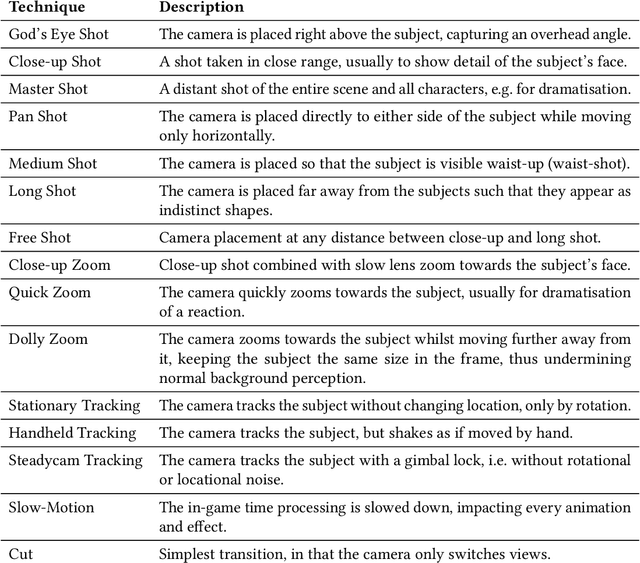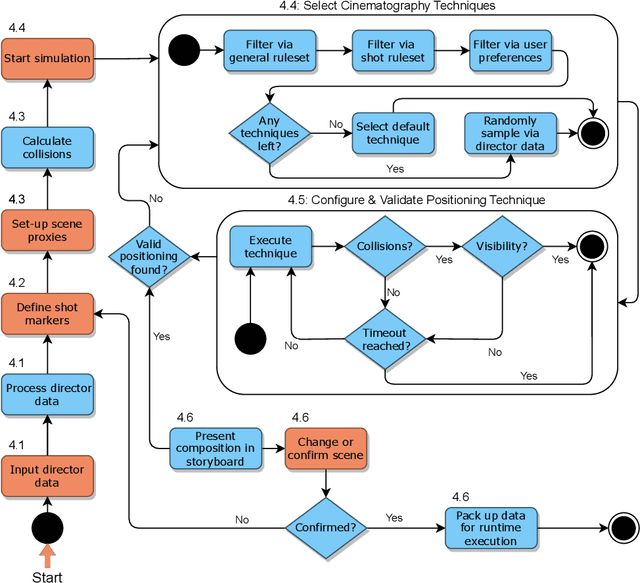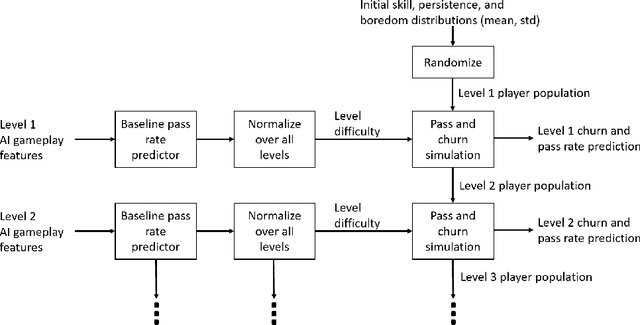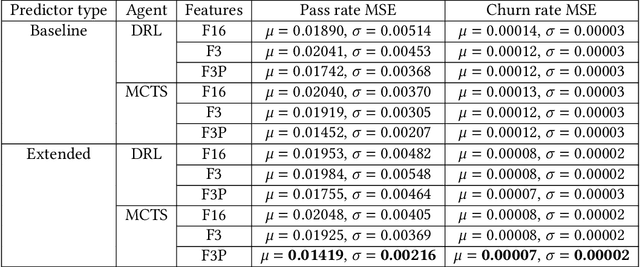Christian Guckelsberger
Computational Creativity Group, Department of Computing, Goldsmiths, University of London, London, UK
Towards a Formal Theory of the Need for Competence via Computational Intrinsic Motivation
Feb 11, 2025Abstract:Computational models offer powerful tools for formalising psychological theories, making them both testable and applicable in digital contexts. However, they remain little used in the study of motivation within psychology. We focus on the "need for competence", postulated as a key basic human need within Self-Determination Theory (SDT) -- arguably the most influential psychological framework for studying intrinsic motivation (IM). The need for competence is treated as a single construct across SDT texts. Yet, recent research has identified multiple, ambiguously defined facets of competence in SDT. We propose that these inconsistencies may be alleviated by drawing on computational models from the field of artificial intelligence, specifically from the domain of reinforcement learning (RL). By aligning the aforementioned facets of competence -- effectance, skill use, task performance, and capacity growth -- with existing RL formalisms, we provide a foundation for advancing competence-related theory in SDT and motivational psychology more broadly. The formalisms reveal underlying preconditions that SDT fails to make explicit, demonstrating how computational models can improve our understanding of IM. Additionally, our work can support a cycle of theory development by inspiring new computational models formalising aspects of the theory, which can then be tested empirically to refine the theory. While our research lays a promising foundation, empirical studies of these models in both humans and machines are needed, inviting collaboration across disciplines.
Diversity Progress for Goal Selection in Discriminability-Motivated RL
Nov 03, 2024Abstract:Non-uniform goal selection has the potential to improve the reinforcement learning (RL) of skills over uniform-random selection. In this paper, we introduce a method for learning a goal-selection policy in intrinsically-motivated goal-conditioned RL: "Diversity Progress" (DP). The learner forms a curriculum based on observed improvement in discriminability over its set of goals. Our proposed method is applicable to the class of discriminability-motivated agents, where the intrinsic reward is computed as a function of the agent's certainty of following the true goal being pursued. This reward can motivate the agent to learn a set of diverse skills without extrinsic rewards. We demonstrate empirically that a DP-motivated agent can learn a set of distinguishable skills faster than previous approaches, and do so without suffering from a collapse of the goal distribution -- a known issue with some prior approaches. We end with plans to take this proof-of-concept forward.
On Creativity and Open-Endedness
May 28, 2024Abstract:Artificial Life (ALife) as an interdisciplinary field draws inspiration and influence from a variety of perspectives. Scientific progress crucially depends, then, on concerted efforts to invite cross-disciplinary dialogue. The goal of this paper is to revitalize discussions of potential connections between the fields of Computational Creativity (CC) and ALife, focusing specifically on the concept of Open-Endedness (OE); the primary goal of CC is to endow artificial systems with creativity, and ALife has dedicated much research effort into studying and synthesizing OE and artificial innovation. However, despite the close proximity of these concepts, their use so far remains confined to their respective communities, and their relationship is largely unclear. We provide historical context for research in both domains, and review the limited work connecting research on creativity and OE explicitly. We then highlight specific questions to be considered, with the eventual goals of (i) decreasing conceptual ambiguity by highlighting similarities and differences between the concepts of OE, (ii) identifying synergy effects of a research agenda that encompasses both OE and creativity, and (iii) establishing a dialogue between ALife and CC research.
Creativity and Markov Decision Processes
May 23, 2024Abstract:Creativity is already regularly attributed to AI systems outside specialised computational creativity (CC) communities. However, the evaluation of creativity in AI at large typically lacks grounding in creativity theory, which can promote inappropriate attributions and limit the analysis of creative behaviour. While CC researchers have translated psychological theory into formal models, the value of these models is limited by a gap to common AI frameworks. To mitigate this limitation, we identify formal mappings between Boden's process theory of creativity and Markov Decision Processes (MDPs), using the Creative Systems Framework as a stepping stone. We study three out of eleven mappings in detail to understand which types of creative processes, opportunities for (aberrations), and threats to creativity (uninspiration) could be observed in an MDP. We conclude by discussing quality criteria for the selection of such mappings for future work and applications.
Towards Mode Balancing of Generative Models via Diversity Weights
Apr 24, 2023Abstract:Large data-driven image models are extensively used to support creative and artistic work. Under the currently predominant distribution-fitting paradigm, a dataset is treated as ground truth to be approximated as closely as possible. Yet, many creative applications demand a diverse range of output, and creators often strive to actively diverge from a given data distribution. We argue that an adjustment of modelling objectives, from pure mode coverage towards mode balancing, is necessary to accommodate the goal of higher output diversity. We present diversity weights, a training scheme that increases a model's output diversity by balancing the modes in the training dataset. First experiments in a controlled setting demonstrate the potential of our method. We conclude by contextualising our contribution to diversity within the wider debate on bias, fairness and representation in generative machine learning.
"An Adapt-or-Die Type of Situation": Perception, Adoption, and Use of Text-To-Image-Generation AI by Game Industry Professionals
Feb 27, 2023Abstract:Text-to-image generation (TTIG) models, a recent addition to creative AI, can generate images based on a text description. These models have begun to rival the work of professional creatives, and sparked discussions on the future of creative work, loss of jobs, and copyright issues, amongst other important implications. To support the sustainable adoption of TTIG, we must provide rich, reliable and transparent insights into how professionals perceive, adopt and use TTIG. Crucially though, the public debate is shallow, narrow and lacking transparency, while academic work has focused on studying the use of TTIG in a general artist population, but not on the perceptions and attitudes of professionals in a specific industry. In this paper, we contribute a qualitative, exploratory interview study on TTIG in the Finnish videogame industry. Through a Template Analysis on semi-structured interviews with 14 game professionals, we reveal 12 overarching themes, structured into 49 sub-themes on professionals' perception, adoption and use of TTIG systems in games industry practice. Experiencing (yet another) change of roles and creative processes, our participants' reflections can inform discussions within the industry, be used by policymakers to inform urgently needed legislation, and support researchers in games, HCI and AI to support the sustainable, professional use of TTIG to benefit people and games as cultural artefacts.
Cine-AI: Generating Video Game Cutscenes in the Style of Human Directors
Aug 11, 2022



Abstract:Cutscenes form an integral part of many video games, but their creation is costly, time-consuming, and requires skills that many game developers lack. While AI has been leveraged to semi-automate cutscene production, the results typically lack the internal consistency and uniformity in style that is characteristic of professional human directors. We overcome this shortcoming with Cine-AI, an open-source procedural cinematography toolset capable of generating in-game cutscenes in the style of eminent human directors. Implemented in the popular game engine Unity, Cine-AI features a novel timeline and storyboard interface for design-time manipulation, combined with runtime cinematography automation. Via two user studies, each employing quantitative and qualitative measures, we demonstrate that Cine-AI generates cutscenes that people correctly associate with a target director, while providing above-average usability. Our director imitation dataset is publicly available, and can be extended by users and film enthusiasts.
How Does Embodiment Affect the Human Perception of Computational Creativity? An Experimental Study Framework
May 03, 2022
Abstract:Which factors influence the human assessment of creativity exhibited by a computational system is a core question of computational creativity (CC) research. Recently, the system's embodiment has been put forward as such a factor, but empirical studies of its effect are lacking. To this end, we propose an experimental framework which isolates the effect of embodiment on the perception of creativity from its effect on creativity per se. We not only manipulate the system's embodiment, but also the perceptual evidence as the basis for the human creativity assessment. We motivate the core framework with embodiment and perceptual evidence as independent and the creative process as controlled variable, and we provide recommendations on measuring the assessment of creativity as dependent variable. We hope the framework will inspire others to study the human perception of embodied CC in a principled manner.
Predicting Game Engagement and Difficulty Using AI Players
Jul 26, 2021



Abstract:This paper presents a novel approach to automated playtesting for the prediction of human player behavior and experience. It has previously been demonstrated that Deep Reinforcement Learning (DRL) game-playing agents can predict both game difficulty and player engagement, operationalized as average pass and churn rates. We improve this approach by enhancing DRL with Monte Carlo Tree Search (MCTS). We also motivate an enhanced selection strategy for predictor features, based on the observation that an AI agent's best-case performance can yield stronger correlations with human data than the agent's average performance. Both additions consistently improve the prediction accuracy, and the DRL-enhanced MCTS outperforms both DRL and vanilla MCTS in the hardest levels. We conclude that player modelling via automated playtesting can benefit from combining DRL and MCTS. Moreover, it can be worthwhile to investigate a subset of repeated best AI agent runs, if AI gameplay does not yield good predictions on average.
Automating Generative Deep Learning for Artistic Purposes: Challenges and Opportunities
Jul 05, 2021

Abstract:We present a framework for automating generative deep learning with a specific focus on artistic applications. The framework provides opportunities to hand over creative responsibilities to a generative system as targets for automation. For the definition of targets, we adopt core concepts from automated machine learning and an analysis of generative deep learning pipelines, both in standard and artistic settings. To motivate the framework, we argue that automation aligns well with the goal of increasing the creative responsibility of a generative system, a central theme in computational creativity research. We understand automation as the challenge of granting a generative system more creative autonomy, by framing the interaction between the user and the system as a co-creative process. The development of the framework is informed by our analysis of the relationship between automation and creative autonomy. An illustrative example shows how the framework can give inspiration and guidance in the process of handing over creative responsibility.
 Add to Chrome
Add to Chrome Add to Firefox
Add to Firefox Add to Edge
Add to Edge